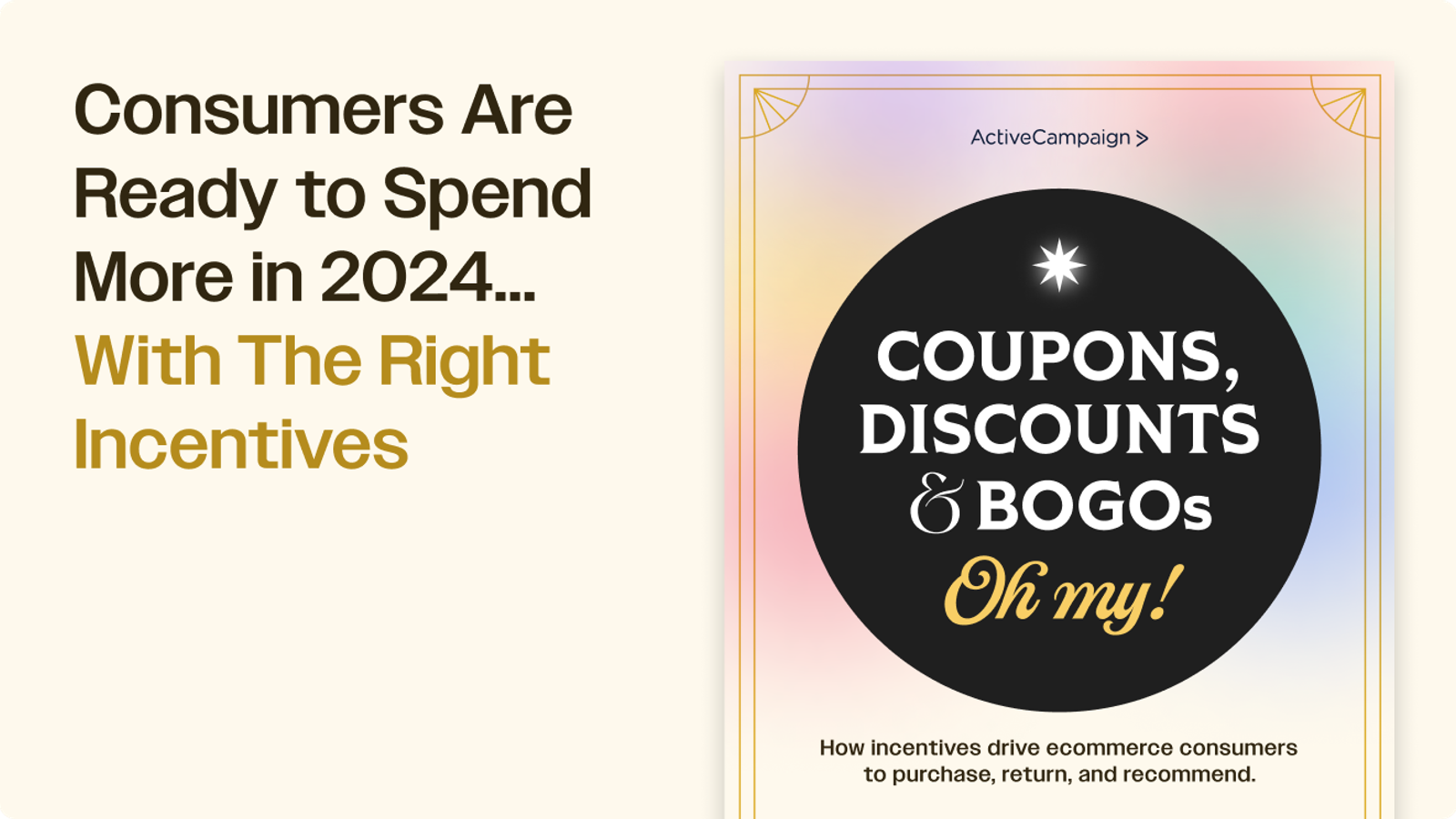
Ecommerce is growing. With this increase comes a whole new set of trends to keep up with.
So, where does that leave us in 2021, and what can we expect from 2022?
In this article, we’ll outline the upcoming ecommerce trends for 2022. We’ll also look at what’s going well in 2021 and what we thought would be a success but didn’t quite take off.
2022 ecommerce trends (quick take)
- Global ecommerce sales will continue to rise
- Buyers will keep using mobile to shop online
- Personalization is here to stay
- Ecommerce brands need to be eco-conscious
- Social media will continue to influence online sales (especially for young people)
In this deep dive on ecommerce trends, we’ll also cover:
- Ecommerce Marketing and Sales Trends for 2022
- What’s been working in 2021?
- Personalization
- Mobile commerce
First, what worked in 2021?
Before you look ahead to 2022, let’s reflect on what’s been popular throughout 2021.
Personalization
Personalization allows businesses to create a tailored customer experience across multiple channels. From personalizing your website to creating custom audience groups on social media, consumers are shown information that’s relevant to their stage in their customer journey.
Because of the pandemic, businesses turned to personalization to provide their customers with a better online experience. Since then, more ecommerce companies have planned to invest more in personalization for 2021.
With more personalization, consumers are receiving a better experience. In 2021, 52% of consumers said that their satisfaction improved with a more personalized experience.
Evidence suggests personalization will be around for the foreseeable future. The use of customer behavior analytics is expected to grow 20% from 2020 to 2025. It’s also unlikely that customers will lower their expectations when it comes to their online experience.
So what does this mean for the future of personalization?
There’s a lot that ecommerce businesses can achieve with personalization as we head into 2022. We’ll talk about this in more detail later, so stay tuned.
Mobile commerce
In 2021, more people will use a mobile device than ever before (5.27 billion). And with more people using their mobile phones, mobile commerce has become pretty popular.
Mobile commerce is forecast to account for nearly 6% of all retail sales in 2021, and mobile shopping’s share of ecommerce increased from 70.4% in 2020 to 72.9% in 2021.
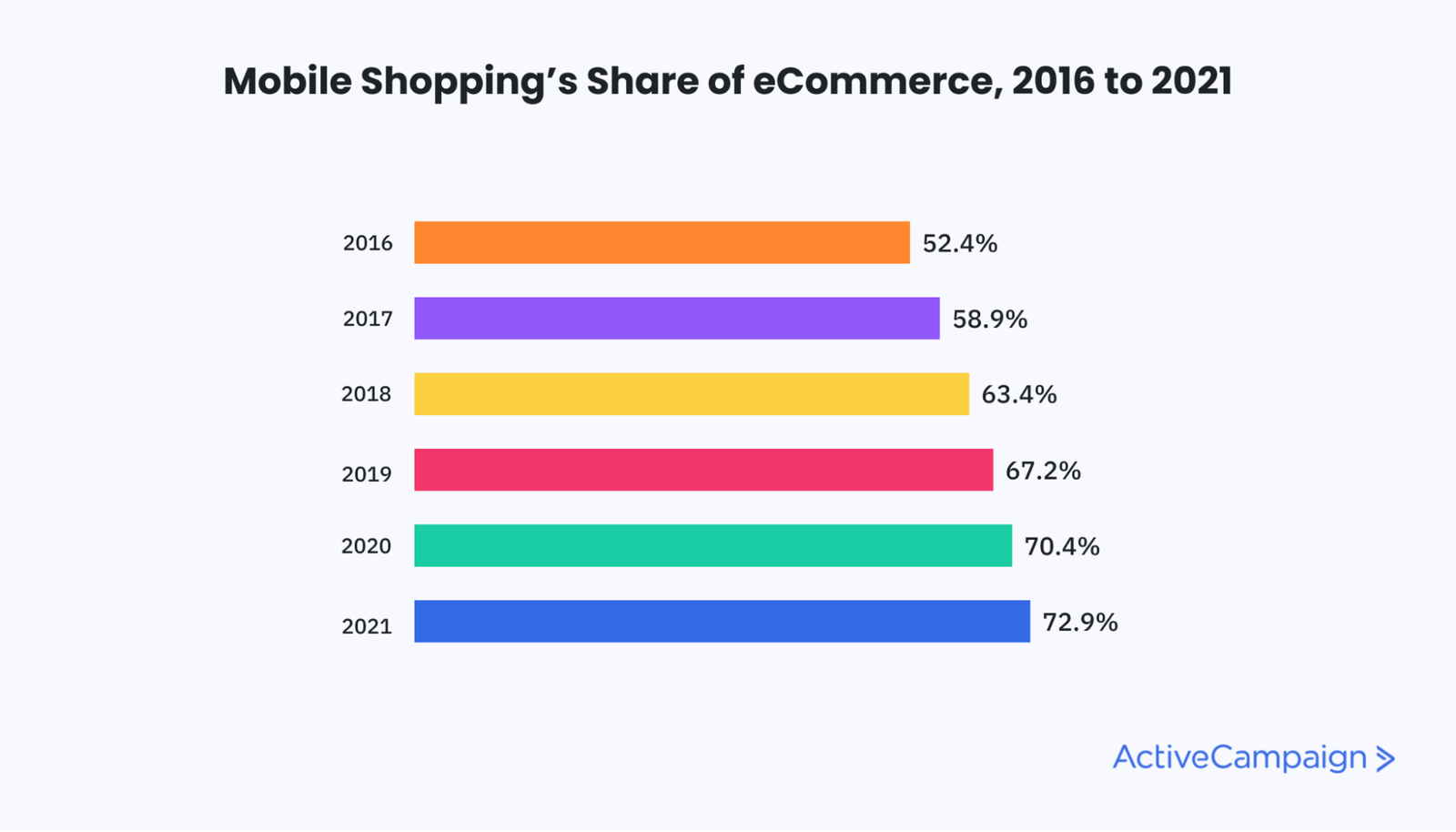
Put simply, mobile commerce is here to stay — and it’s a valuable tool for every ecommerce company.
If you’re not already using a mobile-friendly version of your ecommerce site, consider doing it sooner rather than later. Failing to do so could mean that you’ll miss out on potential customers. And don’t worry, we’ve outlined some mobile-friendly website best practices for you later in the article.
What we thought was going to be big, but wasn’t: Voice commerce
Over the past few years, we’ve seen a lot of hype around voice commerce.
If you’re not familiar with the concept, it involves using voice to search and shop online with a smart device. Using voice assistant tools like Alexa and Siri, consumers can find what they’re looking for and make a purchase without having to touch or type.
Research suggests that by 2030, voice commerce will account for 30% of overall ecommerce sales. As for 2021, voice commerce simply hasn’t been as popular as expected. Not least of all because a lot of retail websites aren’t enabled for voice search.
Take a look at retailers in the UK, for example: 88% of them haven’t enabled voice-activated search on their websites.
Studies also show that 95% of voice search users experience problems with it. To us, it doesn’t sound like a very efficient method of online shopping.
Until technology can keep up with consumer demand (in this case, that’s understanding what they’re searching for), it’s unlikely to grow at the predicted rate.
What are the latest trends in ecommerce for 2022?
We’ve covered 2021. Now, let’s take a look at what we can expect for 2022 and how you can use these trends to grow and develop your ecommerce business.
1. Global ecommerce sales will continue to rise
With more people shopping online, we saw a big spike in ecommerce sales in 2020. As expected, this slowed down in 2021 — but the percentage of ecommerce sales still grew 1.5% from 2020 to 2021.

What does this tell us?
Ecommerce is sticking around for the long haul. Research predicts that ecommerce sales will reach $5.4 trillion by 2022.
How to take action: Prepare your business for growth
With ecommerce growth continuing into 2022, you need to make sure your business is ready to handle growth, too.
Here’s what we’d suggest:
- Refine your business plan: To prepare for growth, you need a solid business plan in place that outlines your goals. If you don’t, your business could lack direction. Spend some time making sure your business plan is up to date and ready to adapt to business growth.
- Monitor every ecommerce trend: Keep an eye on any trends in the ecommerce industry and be proactive. This will make sure that your business adapts to change, giving it the best chance of growth and success.
2. Buyers will keep using mobile to shop online
More people have been using mobile devices to shop online, which will only increase in 2022.
Studies show that mobile commerce sales grew at a rate of 41.4% in 2020 and will grow another 15.2% in 2021 to reach $359.32 billion.
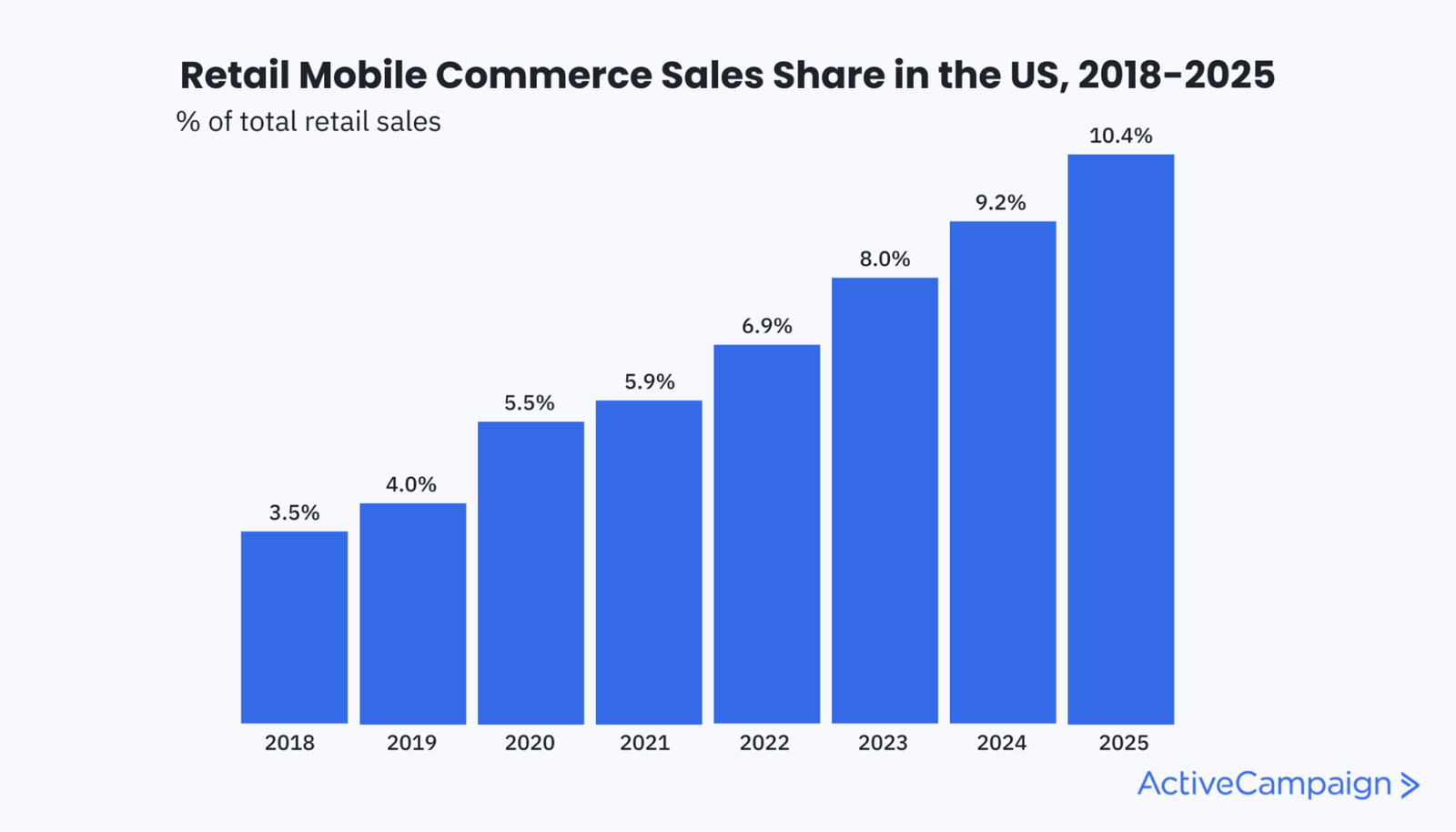
Between now and 2025, annual mobile sales should nearly double. By the time 2025 rolls around, over 10% of all retail sales in the U.S. will be generated via mobile commerce.
How to take action: Optimize your ecommerce website for mobile
Simply put, if you don’t have a mobile-friendly version of your website, you could be missing out on potential sales.
Let’s look at how you can optimize your site for mobile (and why optimizing for email is a good idea, too).
- Use an ecommerce platform with a responsive website design: A responsive website means that your site will automatically change its layout based on the device the visitor is using. Whether it’s mobile, desktop, or tablet, your website will do the hard work for you and structure itself accordingly.
- Test it with Google: Google allows you to test the usability of your mobile website. Simply copy the URL into the site, and it’ll review how mobile-friendly it is. If there are any areas of improvement, you can make the necessary changes.
- Make your emails mobile-friendly, too: It isn’t just your website that you should think about when it comes to being mobile-friendly. If most of your users are on mobile, your emails need to be optimized too. Take a look at ActiveCampaign’s mobile-friendly emails to see how you can create an email campaign that’s perfect for all devices.

3. Personalization is here to stay
Consumers are used to a personalized digital experience. How do you think they’d react if it was suddenly taken away?
In 2021, 45% of consumers will take their business elsewhere if brands don’t offer a personalized experience. 60% of consumers also said they’d buy again after a personalized shopping experience. That’s up 16% from 2017.
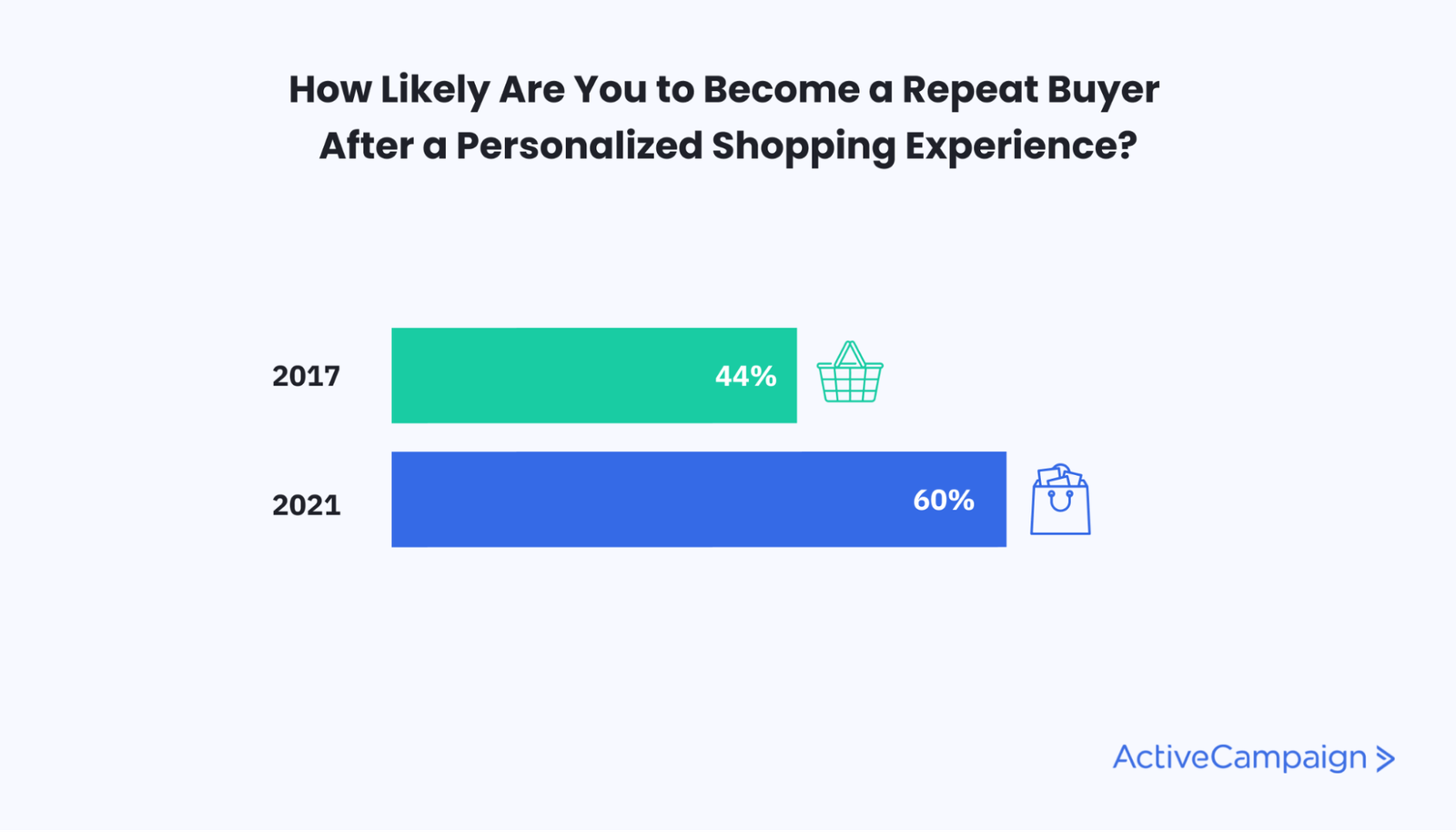
So it’s clear that personalization will continue to influence buyer behavior throughout 2022, if not further.
But there’s still room for improvement.
85% of businesses say they’re providing personalized experiences to consumers, but only 60% say they receive personalized experiences. And 6 out of 10 shoppers get frustrated when sites don’t tailor search results based on their past search queries or online behavior.
How to take action: Personalize the customer journey
Businesses need to close the gap and make sure personalization is a reality for their consumers.
Let’s take a closer look at how you can make this happen.
- Personalize the right channels: It’s no use personalizing platforms that your customers don’t use, so figure out what channels they’re on. You can use data from your existing customers and online traffic analysis or look at some third-party research. For example, studies show that email is the most popular form of personalized communication (78%) followed by websites (56%).
- Choose an all-inclusive personalization platform: Businesses think they’re personalizing the customer journey, but not all customers think they’re getting a personalized experience. To avoid this happening to your customers, use a platform that allows you to personalize every stage of the customer journey. Take a look at ActiveCampaign, for example. With our marketing automation platform, you can create a personalized experience through email, website, and (using our integrations) social media.
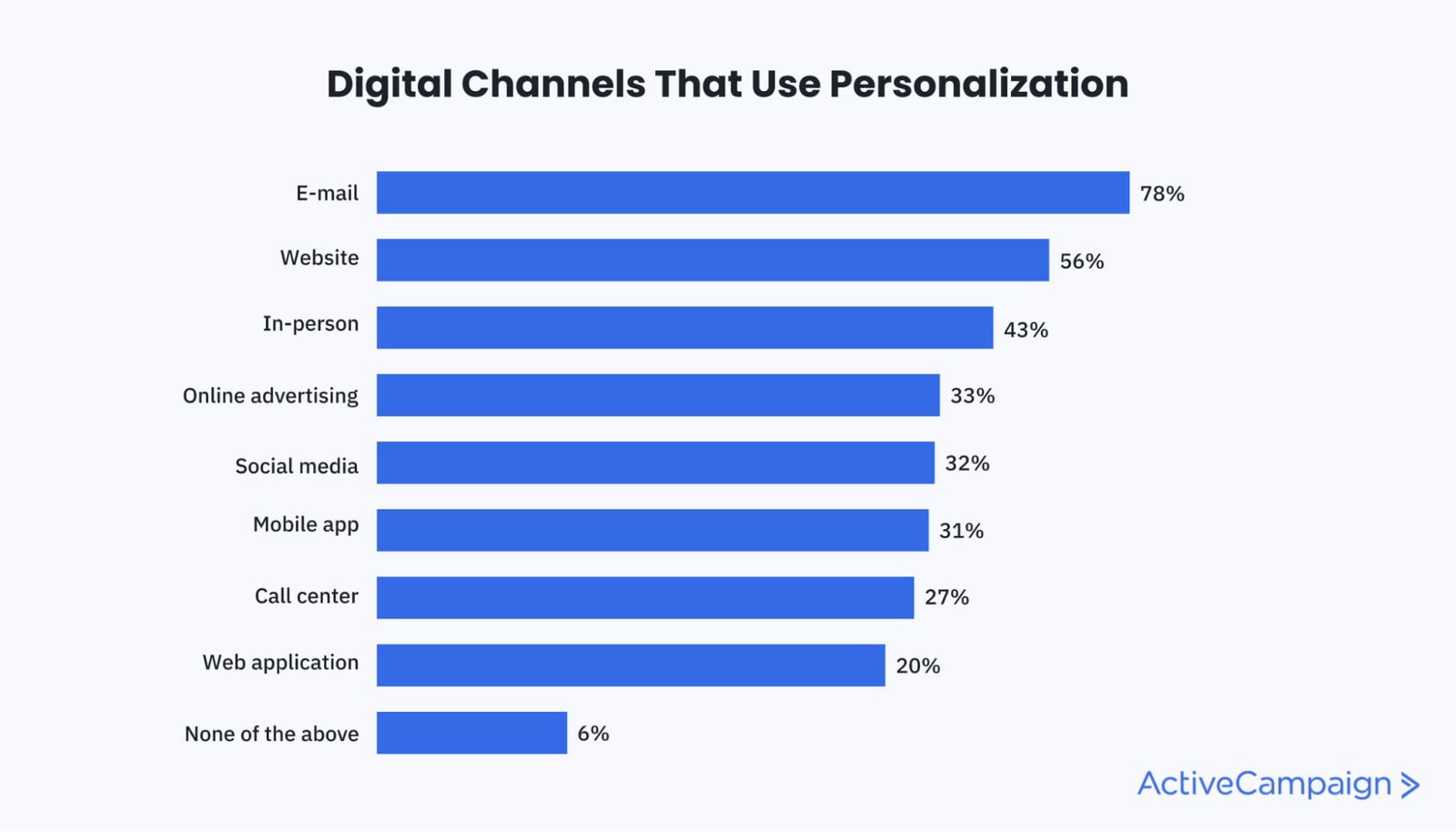
To see how our personalization helps ecommerce businesses, take a look at Hollis. Using ActiveCampaign to personalize their emails, the company has generated over €2,600 from emails alone since their online store launched.
4. Ecommerce brands need to be eco-conscious
Consumers are more selective and thoughtful with their purchases when it comes to sustainability.
56% of consumers say a company’s environmental and social practices can influence their buying decision. 60% of internet users say they’ll pay more for eco-friendly products, and 51% say they want brands to focus on being eco-friendly.
People would rather buy from eco-friendly companies, and they’d pay more for a product that’s sustainably sourced.
So as an ecommerce brand, think about how you can make your brand more sustainable and how to promote it.
How to take action: Become as sustainable as possible
As an online retailer, how can you become more sustainable? And better yet, how can you promote it effectively?
First things first, you need to identify areas where you can become more sustainable. To give you some inspiration, here are some of the steps that consumers want brands to take:
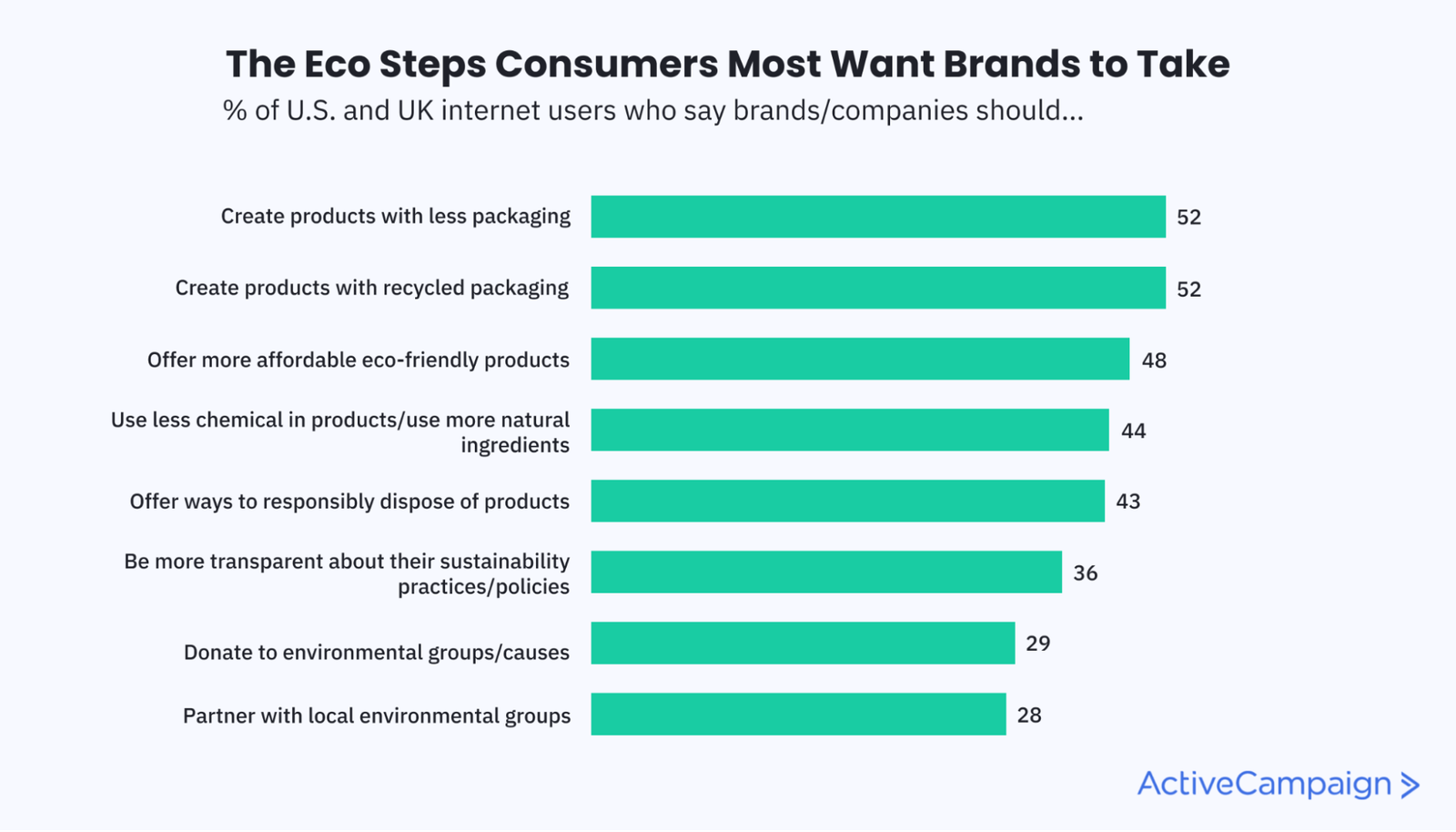
Once you’ve figured out how to become more sustainable, you need to show consumers what you’re doing.
Here’s what you need to do:
- Use social media: Create a social media campaign to raise awareness around your sustainability. That’ll show your customers (both existing and potential) what you’re doing to be more eco-conscious.
- Create a web page: Build a web page to show visitors the steps you’re taking to be environmentally friendly. Take a look at PWC’s corporate responsibility page as an example.
5. Social media will influence online sales (especially for young people)
35.9% of U.S. internet users will purchase through social media by the end of 2021. This will result in social commerce sales growing more than 35% throughout the year, surpassing $36 billion.
Ecommerce brands need to utilize social media in 2022 — and this is especially relevant if you’re targeting a younger target audience.
Why?
Because younger consumers shop on social media more than any other age group.
28% of younger online shoppers said they purchased via social media, compared to 20% of consumers aged 35-54 and 8% of consumers aged 55+.
Not to mention, 54% of younger consumers discover brands via social media, the highest amount compared to other age groups.
How to take action: Create an effective social media strategy
To make the most of social media in 2022, we’d suggest creating a social media strategy.
Here are a few tips to get you started:
- Establish goals: Without goals in place, it’ll be hard to track progress. Set social media goals and milestones from the outset to measure success throughout your strategy.
- Use the right social media platform: Just because Facebook is the top social commerce platform doesn’t mean it’s the right platform for your business. You need to find out what platforms your audience is using and incorporate these into your strategy.
- Be consistent: Consistency is key when it comes to social media. Regular posting shows consumers you’re active and keeps them engaged with your brand. Consider social media scheduling to help you keep on top of this.
- Monitor results: Keep on top of your social media results. If things aren’t going to plan, you can make adjustments as needed.
Improve your ecommerce sales with customer experience automation
One of the key trends we’re seeing is the increasing need for a personalized experience. If you’re thinking about using personalization in your customer journey, take a look at ActiveCampaign.
Our customer experience automation platform gives you all the tools you need to provide a personalized experience to customers.








